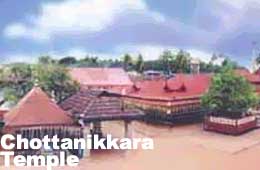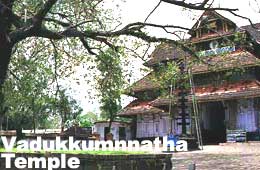| India Profile » Monuments and Temples in India » Temples of Kerala | |
Temples of Kerala | |
 | |
 The architectural style of the temples in Kerala is different from the other areas in India. The geographical features of the place largely determine the temple style of a region. Kerala has rich forest cover together with good monsoon showers thus resulting in distinctive structures of the temples. The roofs of the temples are steep and needlelike covered with copper sheets. The roofs of the temples of Kerala are similar to the temples of the Himalayan regions and the East Asia. The shape of the roof depends on the plan of the sanctum below. A circular plan has a conical roof, while a square plan has a pyramidal roof. The roof is made of wood and is covered with copper plates. Most of the temples in Kerala have undergone renovation several time ever since their construction because of the perishable construction materials. The history of the construction of the temples of Kerala dates back to the Cheras of the 3rd century BC. The temples of Kerala are referenced in the works of the Tamil Alwar Saints and the Nayanmar Saints. Several works on the temple architecture were written in Kerala during the 15th and the 16th centuries AD. The Bhakti literatures of the 16th century played an important role in the temple culture of Kerala.The Maharajas of Travancore were ardent patrons of temples. Temples have held an important place in the life of the people of Kerala. Several temples in Kerala trace their origins to antiquity. However, they were renovated frequently and the current structures that are seen are vastly a result of the numerous renovations. The Chottanikkara temple is located near Ernakulam. It is one of the most popular deities in Kerala and enshrines Bhagawati-the mother Goddess. The Poornatrayesa temple at Tripunittura is on the way. The goddess is worshipped here along with Lord Vishnu. People with mental illness come to seek blessings of the divine mother, who graciously cures all her devotees. Goddess Rajrajeshwari is the presiding deity. The goddess is worshipped in three different forms during the entire day - as Saraswati, draped in white, in the morning, as Bhadrakali, draped in crimson at noon and as Durga, draped in blue, in the evening. The image in the sanctum is not fixed to the ground but is mounted on loose sand. Water offered during ablution ceremonies percolates underground through the sand. The Sri Krishna Temple is situated at Guruvayoor and is one of the most sacred and important pilgrim centers of Kerala. This is probably the only temple in the state that hosts the maximum number of marriages and annaprashana ceremonies, the ritual first meal for infants. According to local legends, the'Guru' or the 'preceptor of the gods' and 'Vayu' or the 'god of winds' build the temple. The Chuttambalam or the outer enclosure contains a 33.5-m tall gold-plated 'Dwajastambham' or the flag post. A 7 m high 'Deepastambham' or the pillar of lamps with thirteen circular receptacles is also there providing a truly brilliant sparkle, when lit. The main deity presides in the square 'Sri Kovil' is the sacred sanctum of the temple. The temple also contains the images of Ganapathy, Sri Ayyappa and Edathedathy Kavil Bhagavathy. Non-Hindus are not allowed inside the temple.
The Vadukkumnnatha is an important Shiva temple situated at Trichur in Kerala. It is one of the most ancient shrines of Kerala, which also has a museum of ancient wall paintings, woodcarvings and art pieces of great historical value. The 'Pooram Festival' is celebrated in April/ May. It attracts thousands of devotees and tourists from all over the world. The festival is a spectacular event, where you can see the majestic elephant parade with the wild playing of drums and cymbals finished off with the extravagant fireworks. |
|
 |
 The Sabrimala is a holy shrine dedicated to Lord Ayyappa. It is also a renowned pilgrim center over the top of the rugged hills of the Western Ghats. The sanctum sanctorum is almost 914 m above the mean sea level surrounded by the thick forests of the Western Ghats. The pilgrimage is generally undertaken between November and January. The pilgrims, regardless of caste, creed, and color wear black dhotis and carry the bundles containing the traditional offerings like coconut filled with ghee, camphor and rice over their head. The Sabarimala Temple festival is celebrated in honor of Lord Ayyapan. The two main ceremonies called the Mandal Puja and the Makara Sankranti Puja are celebrated from November to Mid- January in Kerala. During this time, the devotees perform austerities and penitence.
The Sabrimala is a holy shrine dedicated to Lord Ayyappa. It is also a renowned pilgrim center over the top of the rugged hills of the Western Ghats. The sanctum sanctorum is almost 914 m above the mean sea level surrounded by the thick forests of the Western Ghats. The pilgrimage is generally undertaken between November and January. The pilgrims, regardless of caste, creed, and color wear black dhotis and carry the bundles containing the traditional offerings like coconut filled with ghee, camphor and rice over their head. The Sabarimala Temple festival is celebrated in honor of Lord Ayyapan. The two main ceremonies called the Mandal Puja and the Makara Sankranti Puja are celebrated from November to Mid- January in Kerala. During this time, the devotees perform austerities and penitence.